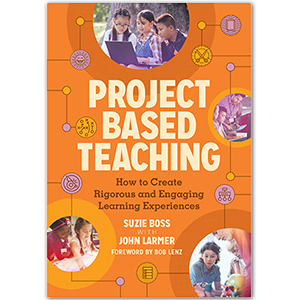(This is an excerpt from our new book, Project Based Teaching: How to Create Rigorous and Engaging Learning Experiences, by Suzie Boss with John Larmer.)
 Many more opportunities to engage and coach emerge as the project unfolds. Like a sports coach, you size up the talents and skills of your “players” and plan learning activities that are just challenging enough to help each improve. You break complicated tasks and ideas into right-sized chunks or steps; scaffold the development of new skills; provide time to practice; and offer constructive, timely feedback. When students make gains or breakthroughs in understanding, you encourage them to reflect on their own growth and set new goals. You celebrate the small wins that will add up to deeper learning.
Many more opportunities to engage and coach emerge as the project unfolds. Like a sports coach, you size up the talents and skills of your “players” and plan learning activities that are just challenging enough to help each improve. You break complicated tasks and ideas into right-sized chunks or steps; scaffold the development of new skills; provide time to practice; and offer constructive, timely feedback. When students make gains or breakthroughs in understanding, you encourage them to reflect on their own growth and set new goals. You celebrate the small wins that will add up to deeper learning.
A coach is also good at reading the temperature of the room. You pay attention to how teams are getting along (or not) and step in when needed to help manage conflict. If students hit roadblocks, you help them learn from failure—and then recover. You know when they need a pep talk and when they need to vent their frustration.
“You can feel fatigue in the middle of a long project,”
says Erin Starkey, an instructional coach from Wichita Falls, Texas. If you know your students—a hallmark of a good coach—you’ll be able to read the clues that engagement is flagging. That might be your signal to bring in an outside expert or plan field research to recharge interest in the project.
With elementary students, Starkey uses a project wall to keep artifacts visible. That includes students’ questions. “The board becomes a focal point for students,” she says. “When I know their questions, I can coach better.” Eventually, she says, students start looking at one another’s questions and working together to answer them.
“They coach each other.”
Even when students take the lead in designing their own projects, their interest can wane before they reach their goals. Chemistry teacher Ray Ahmed sometimes has to help students overcome a slump in the middle of extended inquiry projects. “It’s exciting for them in the beginning, but after five weeks they might say, ‘I’m tired of this! I’m sick of the question I came up with!’” The teacher coaches them through that challenge by reminding them that scientists often face the same problem. “That’s a real-world issue,” he admits. Successful scientists develop the perseverance to keep going through setbacks.

Ian Stevenson, director of school development at a high school in Memphis, Tennessee, sees the teacher’s role as “coaching students to work as independently as possible throughout the process.” A teacher as coach should be able to “identify what students need and provide them with resources, encouragement, and redirection as you guide them through the project.”
A good coach also knows when to step back and let students lead. “For me,” Stevenson says, “engagement is when students are actively talking about content and making sense of it. When that’s happening, I need to shut up and let them talk!”
If you notice that students are not driving their own learning, however, you may need to deliberately build the skills of self-management. We heard earlier how Telannia Norfar intervened when she saw her students struggling to work semi-independently. She took back the reins—for a while—and supported students’ self-management skills with daily task logs. Over time, as students developed better work habits, she was able to gradually release more of the responsibility to them.
The teacher as coach not only celebrates small wins but also reengages students who are struggling or straggling. Effective formative assessment (discussed in Chapter 5) helps you identify when students need support—and why. Scaffolding strategies (discussed in Chapter 6) ensure that you are helping all students reach learning goals. An effective PBL teacher knows how to move seamlessly from formative assessment to just-in-time scaffolding.
For example, high school teacher Brian Schoch from Columbus, Ohio, was off and running with a promising project. His business students appeared to be fully engaged in the challenge of designing products that they would market to an audience of 4th graders. Previously, they had researched existing products in their price range and interviewed 4th graders who served as their focus group. Now they were at the stage in the project when it was time for teams to brainstorm product ideas.
As he circulated around the room, Schoch could tell from the conversations that some teams were fully invested in the challenge. “If I heard them brainstorming and suggesting different strategies, I would hang back.” But when he noticed one table where students sat slumped and quiet, struggling to get their creativity flowing, he pulled up a chair and started asking questions.
“What have you tried? What do you remember from talking with the fourth graders? What were your favorite things when you were their age?” His questions were intended to prompt students’ thinking, but he stopped short of offering specific ideas for products.
“I didn’t want them to create something they thought I would like. The ideas had to come from them,” he said.
He also reminded teammates of their goal, defined by the driving question: How can we design a product to appeal to our target audience of 4th graders? After just a few minutes of Schoch’s friendly but deliberate questioning, the group was refocused and generating ideas. The teacher quietly moved on. His teacher moves were quick and effective: listening and observing for evidence of engagement, using open-ended questions to help students get unstuck, encouraging persistence, and helping students refocus on their learning goal.
With practice and reflection, Project Based Teachers become adept at holding students to high standards while still showing care and concern for their struggles. They take on the role of a “warm demander,” a term used by MacArthur Award–winning educator and equity advocate Lisa Delpit (2012). She describes warm demanders as teachers who “expect a great deal of their students, convince them of their own brilliance, and help them to reach their potential in a disciplined and structured environment” (p. 77). Figure 7.2 describes warm demander behaviors, with prompts to consider how to emphasize them in your teaching practice.
When students are building understanding and brainstorming product ideas, apply your “coaching stance” to reinforce a classroom culture of high expectations. Use your project rubric as a focus for coaching conversations about students’ learning goals. Ask questions that help students assess their own progress and work toward excellence. When students are working on products, for example, coach them to take a critical look at their work in progress. Ask questions such as “Is your work good enough? Where would you describe your learning on the rubric today?” These questions facilitate students’ engagement and get them thinking about their own learning. That’s a powerful tool.
Project Based Teaching is available here.
